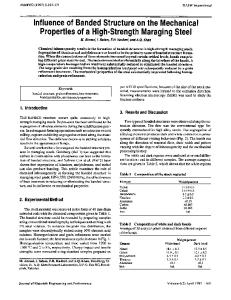Study of the structure and mechanical properties of engineering products made of austenitic-martensitic steel, using the
- PDF / 2,555,518 Bytes
- 9 Pages / 595.276 x 790.866 pts Page_size
- 9 Downloads / 345 Views
RESEARCH PAPER
Study of the structure and mechanical properties of engineering products made of austenitic-martensitic steel, using the metal magnetic memory technique Anatoly Dubov 1
&
Alexander Dubov 1
&
Artem Marchenkov 2
&
Sergey Kolokolnikov 1
Received: 29 August 2019 / Accepted: 15 July 2020 # International Institute of Welding 2020
Abstract Spontaneous phase transformation in local areas of the austenitic microstructure to martensite with the release of carbides may appear during the manufacturing or operation of engineering products made of two-phase austenitic-martensitic steel grades. When inspecting the quality of products made of these steels, the problem of detecting the local zones of the martensitic phase and carbide precipitation in the product metal arises. The article presents the results of an inspection by means of the metal magnetic memory (MMM) technique of centrifugal compressor impellers made of austenitic-martensitic steel 07Cr16Ni6. It was demonstrated that in the areas of stray field indications detected by means of the MMM technique, strength properties deteriorate, the metal structure degrades with abrupt changing of the metal phase composition and a carbide network formation, unacceptable δ-ferrite, was detected in the structure, and micro- and macro-cracks were found. Keywords Dual-phase steel . Metal magnetic memory technique . Non-destructive testing . Stress analysis
1 Introduction Spontaneous phase transformation in local areas of the austenitic microstructure to martensite with the release of carbides may appear in engineering products made of two-phase austenitic-martensitic steel grades. This problem occurs especially frequently during heat treatment and deformation processing, and welding of these steels, as well as during operation of components made of them [1–10]. Recommended for publication by Commission V - NDT and Quality Assurance of Welded Products * Sergey Kolokolnikov [email protected] Anatoly Dubov [email protected] Alexander Dubov [email protected] Artem Marchenkov [email protected] 1
Energodiagnostika Co. Ltd., Moscow, Russia
2
National Research University “Moscow Power Engineering Institute”, Moscow, Russia
When inspecting the quality of products made of these steels, the problem of detecting the local zones of the martensitic phase and carbide precipitation in the product metal arises, respectively. Due to the large difference in austenite and martensite densities, stress concentration occurs at their boundaries. Studies have established that the magnetic metal memory (MMM) technique is an efficient non-destructive testing (NDT) technique for detecting local stress concentration zones (SCZs)1 [11–20]. The MMM technique differs fundamentally from all the known magnetic NDT ones by the fact that its application does not require artificial magnetization of a product, but it uses the natural magnetization formed during the metal cooling below the Curie point in a geomagnetic field [21]. In the course of experimental studies, it
Data Loading...











